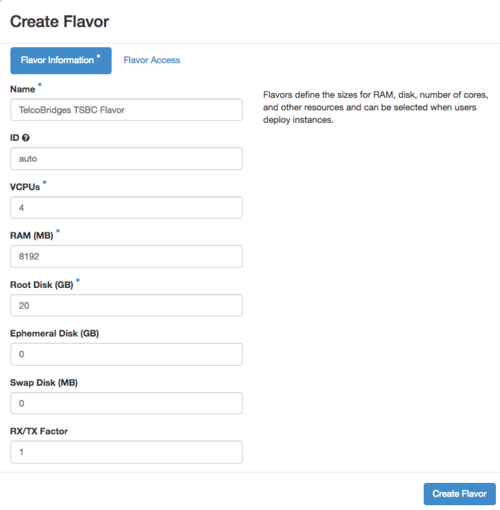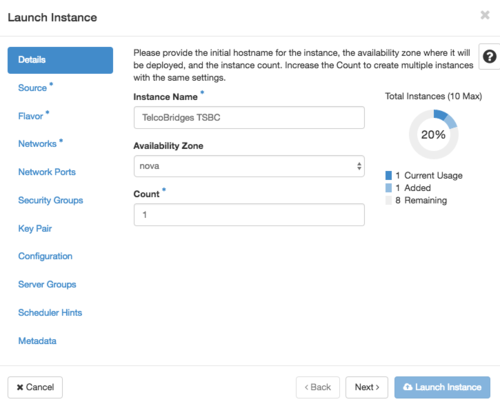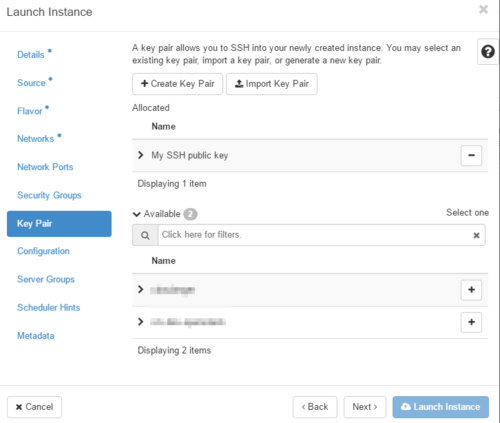FreeSBC:Cloud:OpenStack Installation A
(→Launching an instance) |
(→TSBC OpenStack Instance launch) |
||
| Line 65: | Line 65: | ||
*https://docs.openstack.org/admin-guide/dashboard-manage-images.html | *https://docs.openstack.org/admin-guide/dashboard-manage-images.html | ||
| − | === TSBC OpenStack Instance | + | === TSBC OpenStack Instance === |
Instances are virtual machines that run inside OpenStack's cloud. You will need to launch a new instance from the TSBC Image created in the [[#Upload an Image]] section | Instances are virtual machines that run inside OpenStack's cloud. You will need to launch a new instance from the TSBC Image created in the [[#Upload an Image]] section | ||
Revision as of 12:07, 20 April 2017
Contents |
Requirements
Minimal Cloud requirements:
- 4 VCPU
- 20G hard drive
- 8G RAM
- Virtio NIC interface
For better performance (see optimization section)
- SR-IOV or MacVTap compatible NICs
- Pinned CPU
Getting the Image
Please contact our sales team at sales@telcobridges.com to get a copy of the latest TBSC Image.
Installation on OpenStack cloud
TSBC OpenStack Minimal Flavor
In OpenStack, a flavor defines the compute, memory, and storage capacity of a virtual server, also known as an instance. If you do not already have a flavor that meets the listed minimal requirements, you will have to create a new one.
Creating a Flavor
- Log in to the Dashboard and select the admin project from the drop-down list.
- In the Admin tab, open the System tab and click the Flavors category.
- Click Create Flavor.
- In the Create Flavor window, enter or select the parameters for the flavor in the Flavor Information tab.
- In the Flavor Access tab, you can control access to the flavor by moving projects from the All Projects column to the Selected Projects column.
Only projects in the Selected Projects column can use the flavor. If there are no projects in the right column, all projects can use the flavor. - Click Create Flavor.
References
- https://docs.openstack.org/admin-guide/dashboard-manage-flavors.html
- https://docs.openstack.org/admin-guide/compute-flavors.html
TBSC OpenStack Image
A virtual machine image is a single file that contains a virtual disk that has a bootable operating system installed on it. Images are used to create virtual machine instances within the cloud.
You will need to upload the latest TSBC image into your OpenStack before you can launch a virtual machine instance running the TSBC software.
Upload an Image
Follow this procedure to upload an image to a project:
- Log in to the dashboard.
- Select the appropriate project from the drop down menu at the top left.
- On the Project tab, open the Compute tab and click Images category.
- Click Create Image.
- The Create An Image dialog box appears.
- Enter the following values:
- Image Name : TelcoBridges TSBC xx.yy.zz (Where xxx.yy.zz is changed to the version number of the TSBC image)
- Image Description: TelcoBridges TSBC version xx.yy.zz
- Image Source :File.
- Image File : Browse for the image file on your file system and add it.
- Format: QCOW2
- Architecture: x86_64
- Minimum Disk (GB) : 20
- Minimum RAM (MB): 8192
- Visibility : The access permission for the image. Public or Private, depending on your needs.
- Protected: Select this check box to ensure that only users with permissions can delete the image. Yes or No.
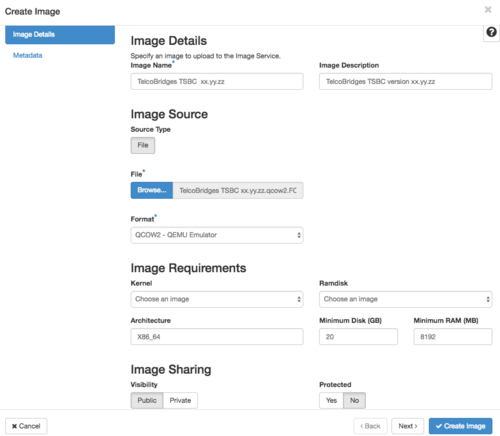
- Image Metadata : Leave empty.
- Click Create Image.
The image is queued to be uploaded. It might take some time before the status changes from Queued to Active.
References
TSBC OpenStack Instance
Instances are virtual machines that run inside OpenStack's cloud. You will need to launch a new instance from the TSBC Image created in the #Upload an Image section
Launching an instance
- Log in to the dashboard.
- Select the appropriate project from the drop down menu at the top left.
- On the Project tab, open the Compute tab and click Instances category.
- The dashboard shows the instances with its name, its private and floating IP addresses, size, status, task, power state, and so on.
- Click Launch Instance.
- In the Launch Instance dialog box, specify the following values:
- Details tab
- Source tab
- Instance Boot Source : Boot from image.
- Create new Volume : No
- Select Image Name : Select TelcoBridges TSBC xx.yy.zz as created in #Upload an Image section.
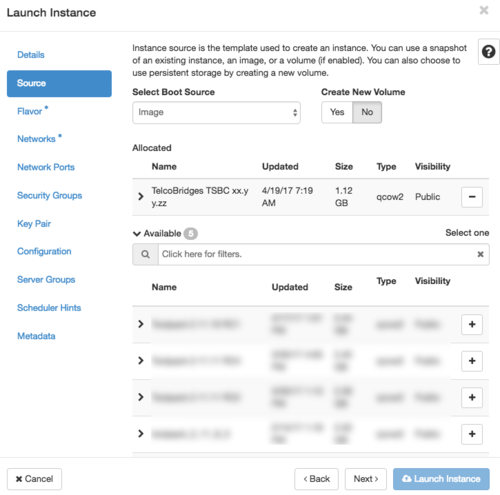
- Flavor tab
- Flavor : Select TelcoBridges TSBC Flavor as created in #Creating a Flavor section.
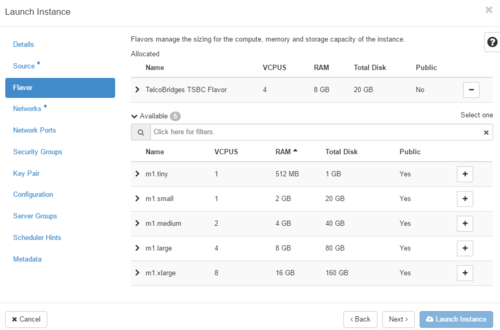
- Flavor : Select TelcoBridges TSBC Flavor as created in #Creating a Flavor section.
- Networks tab
- Selected Networks: If you are installing a standalone SBC, the TSBC will need access to LAN, WAN and MGMT networks. For transcoding on TSBC-TRANS, or HA pair installation, the TSBC will also need access to CTRL0 and CTRL1 networks. Please refer to TSBC-SW:Networking for details on network requirements. Important: For optimal performance, it is recommended to use SR-IOV or MacVTap ports to access LAN, WAN, CTRL0 and CTRL1 networks, see TSBC-SW:Cloud:Optimizations for details.
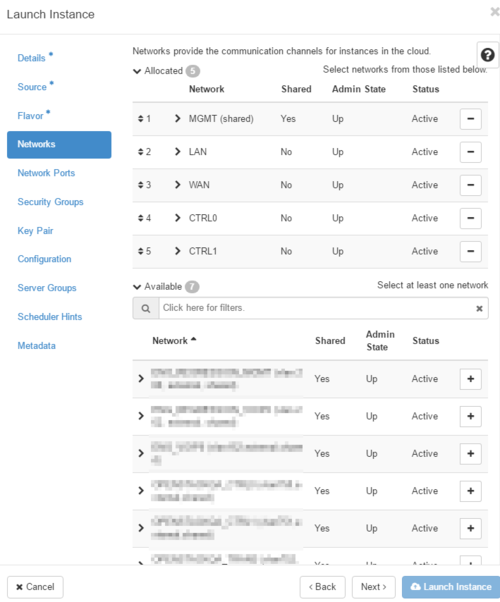
- Selected Networks: If you are installing a standalone SBC, the TSBC will need access to LAN, WAN and MGMT networks. For transcoding on TSBC-TRANS, or HA pair installation, the TSBC will also need access to CTRL0 and CTRL1 networks. Please refer to TSBC-SW:Networking for details on network requirements. Important: For optimal performance, it is recommended to use SR-IOV or MacVTap ports to access LAN, WAN, CTRL0 and CTRL1 networks, see TSBC-SW:Cloud:Optimizations for details.
- Network Ports tab
- Ports : For optimal performances, SR-IOV and MacVTap ports should be used to access LAN, WAN, CTRL0 and CTRL1 networks, instead of attaching to Networks in the Networks Tabs. See TSBC-SW:Cloud:Optimizations for details.
- Security Groups tab
- Security Groups: Activate the security groups that you want to assign to the instance. Security groups are a kind of cloud firewall that define which incoming network traffic is forwarded to instances. If you have not created any security groups, you can assign only the default security group to the instance. Warning: Make sure the selected security group allows ingress traffic.
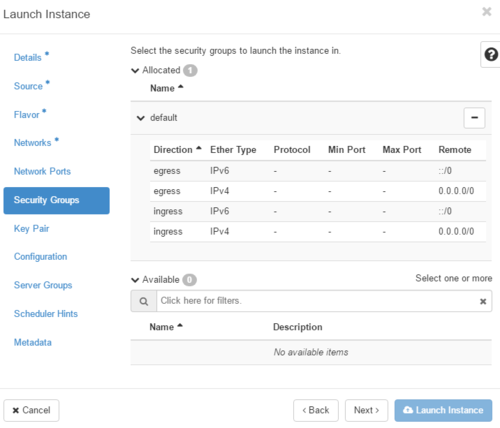
- Security Groups: Activate the security groups that you want to assign to the instance. Security groups are a kind of cloud firewall that define which incoming network traffic is forwarded to instances. If you have not created any security groups, you can assign only the default security group to the instance. Warning: Make sure the selected security group allows ingress traffic.
- Key Pair tab
- Configuration tab
- Customization Script Source : Nothing to do here.
- Metadata tab
- Available Metadata : Nothing to do here.
- Click Launch Instance.
The instance starts on a compute node in the cloud.
References
TBD
Changing the root password
- Use the console to login into the server
- user: root
- password: root
- Change the password to something stronger than root:
# passwd New password: ........ Retype new password: ........ passwd: all authentication tokens updated successfully.
Assigning IP address
- Assign a IP address to the Ethernet interface having network connectivity. Example if the NIC's name would be eth0:
# ip link set eth0 up # ip addresss add 192.168.178.30/24 dev eth0
Accessing the TSBC-SW web portal
- Open a web browser to the IP of your server, on port 12358. Example if your server address is 192.168.178.30, the URL would be:
http://192.168.178.30:12358 - You should get to the TSBC Configuration Wizard
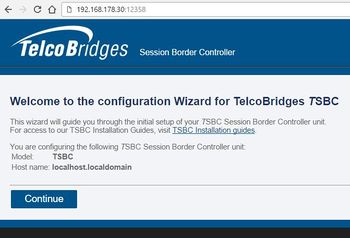
From here, you can go to Web Portal Initial Configuration Guide to continue the installation, and/or optimize your server to get the maximum out of your server.
Web Portal Initial Configuration
Click on the following link to pursue installation from the web portal: TSBC-SW:WebPortal:Initial Configuration
Optimizations
Click on the following link for baremetal server optimizations: TSBC-SW:Baremetal:Optimizations
